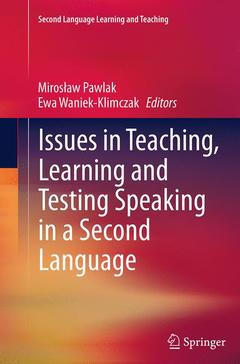Description
Issues in Teaching, Learning and Testing Speaking in a Second Language, 2015
Second Language Learning and Teaching Series
Coordinators: Pawlak Mirosław, Waniek-Klimczak Ewa
Language: English
Subject for Issues in Teaching, Learning and Testing Speaking in a...:
Issues in Teaching, Learning and Testing Speaking in a Second Language
Publication date: 08-2016
Support: Print on demand
Publication date: 08-2016
Support: Print on demand
Issues in Teaching, Learning and Testing Speaking in a Second Language
Publication date: 11-2014
265 p. · 15.5x23.5 cm · Hardback
Publication date: 11-2014
265 p. · 15.5x23.5 cm · Hardback
Description
/li>Contents
/li>Comment
/li>
The volume constitutes a state-of-the-art account of issues related to teaching, learning and testing speaking in a second language. It brings together contributions by Polish and international scholars which seek to create links between theory, research and classroom practice, report the findings of studies investigating the impact of linguistic, cognitive and affective factors on the development and use of speaking skills, and provide concrete pedagogic proposals for instruction and assessment in this area. As such, the book will be of interest not only to second language acquisition theorists and researchers, but also to foreign language teachers willing to enhance the quality of speaking instruction in their classrooms.
Conversational English: Teaching spontaneity.- Local cultures in English: Intercultural communication in an international educational context.- Developing second language oral competence through an integrated discursive approach: The conceptual framework of the project and results of a pilot study.- It’s small words that make a big difference.- Preparing tertiary students for study abroad programs – the identity negotiation perspective.- Correlates and predictors of L2 Willingness to Communicate in Polish adolescents.- Investigating foreign language speaking anxiety among advanced learners of English.- Advanced learners’ use of communication strategies in spontaneous language performance.- Oral communication strategies used by Turkish students learning English as a foreign language.- The effect of diacritics on kinetic tone direction and placement.- Is there any place for silence in the communication-oriented process of adult language learning?.- Videoconferencing as a tool for developing speaking skills.- Using storybooks as a catalyst for negotiating of meaning and enhancing speaking among very young learners of L2: Evidence from a case study.- Business meetings as a genre – pedagogical implications for teaching Business English.- Developing and testing speaking skills in academic discourse.- Designing a self-assessment instrument for developing the speaking skill at the advanced level.
Approaches teaching, learning and testing speaking from a variety of theoretical perspectives Provides an account of original studies investigating different aspects of the development and use of speaking skills Successfully links theoretical positions, empirical evidence and classroom practice Includes supplementary material: sn.pub/extras
© 2024 LAVOISIER S.A.S.
These books may interest you

Testing Second Language Speaking 160.25 €



